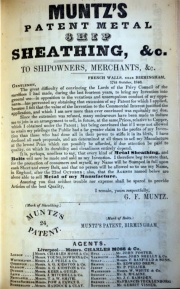Difference between revisions of "George Frederick Muntz"
| Line 1: | Line 1: | ||
[[image:Im1848Sl-Muntz.jpg|thumb| 1848. ]] | [[image:Im1848Sl-Muntz.jpg|thumb| 1848. ]] | ||
George Frederick Muntz ( | George Frederick Muntz (1794-1857), industrialist, inventor and political reformer. | ||
1794 Born in Birmingham son of [[Philip Frederick Muntz]] and his wife Catherine<ref>England, Select Births and Christenings, 1538-1975</ref> | 1794 Born in Birmingham son of [[Philip Frederick Muntz]] and his wife Catherine<ref>England, Select Births and Christenings, 1538-1975</ref> | ||
Revision as of 09:22, 26 September 2016
George Frederick Muntz (1794-1857), industrialist, inventor and political reformer.
1794 Born in Birmingham son of Philip Frederick Muntz and his wife Catherine[1]
His father, on the advice of Matthew Boulton, bought a share in the firm of Mynors/Minors and Robert Purden]], merchants. The firm was later widely known as Muntz and Purden.
c.1807 George Muntz joined the family business at age 13[2].
1811 On the death of his father, George Muntz managed the metalworks which his father had established in Water Street, Birmingham, which presumably was G. F. and P. H. Muntz.
George Muntz made a fortune by the manufacture and application of what became known as Muntz's metal, which was similar to a compound invented previously by James Keir, who took out a patent in 1779 which Matthew Boulton had drawn to the attention of the Admiralty. Whether Muntz knew of Keir's efforts is uncertain but he first introduced the metal into universal use.
Muntz's metal, also known as Yellow metal, consisted of approximately 60% copper and 40% zinc, and often a very small amount of lead. It was patented by George Muntz in 1832 and was specially used for sheathing ships' hulls as a cheaper alternative to pure copper[3]
1822 Birth of son George Frederick Muntz, Junior
1832 Patents numbers 6325 and 6347 are for sheathing for ships and the manufacture of bolts
1837 he became a partner with the copper smelters Pascoe Grenfell and Sons of London and Swansea,
His principal metalworks were at French Wall's, near Birmingham, the location of the Patent Metal Co.
1839 Birth of son Philip Albert Muntz
1840 Elected M.P. for Birmingham.
1841 G F Muntz MP, living in Westminster[4]
1846 patent for an alloy for sheathing ships.
1851 Exhibitor at the Great Exhibition[5].
1851 Living in Handsworth, an M.P. and metal manufacturer, with his wife Eliza age 52 (born in Montgomeryshire), C A Muntz age 16, C S Muntz, age 16, E. G. Muntz age 14, P A Muntz age 12, his niece E C Richardson age 36 and granddaughter E E Muntz, age 3[6]
1852 Mr Muntz was adding to his "immense" establishments in Birmingham and Smethwick with another works on the banks of the Grand Junction Canal and by the Stour Valley Railway to make copper sheathing as at Smethwick[7]
1857 of French Walls, near Birmingham.[8]
1857 Early in May he was showing signs of ill health. He died on 30 July, at Umberslade Hall, Warwickshire.
His younger son Philip Albert Muntz (1839–1908), was Conservative MP for Warwickshire (Tamworth division) from 1884 until his death, and was created a baronet in 1902. He and the eldest son, George Frederick Muntz, Junior, ran the family business after their father's death.
See Also
- George Frederick Muntz, by Samuel Timmins, rev Matthew Lee, ODNB.
Sources of Information
- ↑ England, Select Births and Christenings, 1538-1975
- ↑ George Frederick Muntz, by Samuel Timmins, rev. Matthew Lee, ODNB
- ↑ Morgannwg - Vol. 48 2004 The early zinc works at Casllwchwr (Loughor) near Swansea [1]
- ↑ 1841 census
- ↑ 1851 Great Exhibition: Official Catalogue: Class VIII.: George Frederick Muntz
- ↑ 1851 census
- ↑ The Morning Post, June 28, 1852
- ↑ 1857 Institution of Mechanical Engineers


